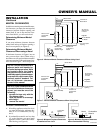
11
105194
OWNER’S MANUAL
CONNECTING TO GAS
SUPPLY
WARNING: A qualified service
person must connect heater to
gas supply. Follow all local codes.
CAUTION: Never connect
heater directly to the propane/LP
supply. This heater requires an
external regulator (not supplied).
Install the external regulator be-
tween the heater and propane/LP
supply.
Installation Items Needed
Before installing heater, make sure you have
the items listed below.
• external regulator (supplied by installer,
see above)
• piping (check local codes)
• sealant (resistant to propane/LP gas)
• equipment shutoff valve *
• test gauge connection *
• sediment trap
• tee joint
• pipe wrench
* A CSA design-certified equipment shutoff
valve with 1/8" NPT tap is an acceptable
alternative to test gauge connection.
The installer must supply an external regu-
lator. The external regulator will reduce
incoming gas pressure. You must reduce
incoming gas pressure to between 11 and 14
inches of water. If you do not reduce incom-
ing gas pressure, heater regulator damage
could occur. Install external regulator with
the vent pointing down as shown in Figure
13. Pointing the vent down protects it from
freezing rain or sleet.
INSTALLATION
Continued
Continued
Figure 12 - Attaching Base Assembly to
Fireplace Floor
Masonry Screw
Mounting
Flange
Installation must include an equipment
shutoff valve, union, and plugged 1/8" NPT
tap. Locate NPT tap within reach for test
gauge hook up. NPT tap must be upstream
from heater (see Figure 14, page 12).
CAUTION: Use only new,
black iron or steel pipe. Inter-
nally-tinned copper tubing may
be used in certain areas. Check
your local codes. Use pipe of 1/2"
diameter or greater to allow
proper gas volume to heater. If
pipe is too small, undue loss of
volume will occur.
We recommend that you install a sediment
trap in supply line as shown in Figure 14,
page 12. Locate sediment trap where it is
within reach for cleaning. Install in piping
system between fuel supply and heater.
Locate sediment trap where trapped matter
is not likely to freeze. A sediment trap traps
moisture and contaminants. This keeps them
from going into heater controls. If sediment
trap is not installed or is installed wrong,
heater may not run properly.
WARNING: Use pipe joint seal-
ant that is resistant to liquid pe-
troleum (LP) gas.
CAUTION: Avoid damage to
control. Hold fitting with wrench
when connecting it to gas piping
and/or fittings.
Figure 13 - External Regulator With Vent
Pointing Down
Propane/LP
Supply
Tank
External Regulator
Vent Pointing Down
3. Place heater base in fireplace.
4. Place logs in their proper position on
heater base (see Installing Logs, page 13).
5. Center heater base and logs front-to-
back and side-to-side in fireplace.
6. Carefully remove logs without moving
heater base.
7. Mark screw locations through one hole
on each side of the mounting bracket
(see Figure 12). If installing in a brick-
bottom fireplace, mark screw locations
in mortar joint of bricks.
8. Remove heater base from fireplace. If
installing optional control accessories,
do so at this time. Follow all directions
provided with accessory.
9. Drill holes at marked locations using
3/16" drill bit.
10. Attach base assembly to fireplace floor
using two masonry screws (in hardware
package).
A
U
T
O
O
F
F
O
N
O
F
F
P
I
L
O
T
O
N
H
I
L
O
H
I
L
O
WARNING: This appliance re-
quires a 1/2" NPT (National Pipe
Thread) inlet connection to the
pressure regulator.
IMPORTANT:
Install an equipment shutoff
valve in an accessible location. The equip-
ment shutoff valve is for turning on or
shutting off the gas to the appliance.
Check your building codes for any special
requirements for locating equipment shutoff
valve to fireplaces.
Apply pipe joint sealant lightly to male NPT
threads. This will prevent excess sealant
from going into pipe. Excess sealant in pipe
could result in clogged heater valves.


















